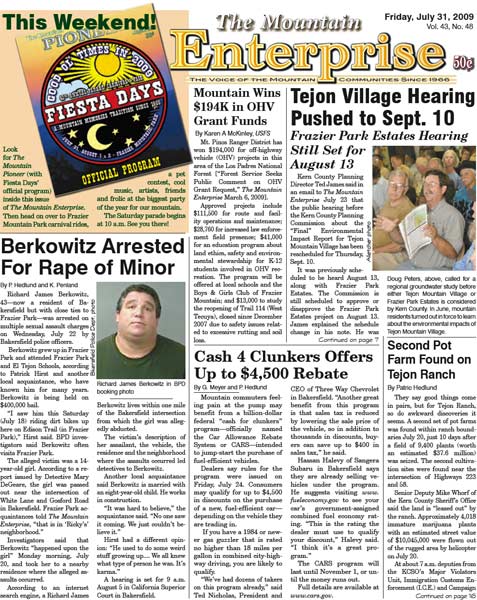By Patric Hedlund
LEBEC (August 4, 2009, 8 a.m.)—Documents kept secret since 1999 about agreements between Tejon Ranch Corporation and the U.S. Fish and Wildlife Service (FWS) that may be critical to the survival of the endangered California condor may soon be released. Environmental organizations party to the Tejon Conservancy contract (that agreed not to participate in public comment debate during the developers’ quest to build out Tejon Mountain Village, Tejon Industrial Park and the 23,000-home Centennial) have written Tejon Ranch management requesting an end to the secrecy.
In April the Center for Biological Diversity (which is not a part of the conservancy agreement) appealed to the Obama Administration for assistance in its efforts to gain public access to the full documents. The documents were not released.
On June 11 the Center for Biological Diversity served official notice that they planned to sue the FWS for access to the information.
The documents had been hidden from the public following a 1997 suit filed by Tejon Ranch Corporation to prohibit the FWS from releasing California condor back into the wild on lands adjacent to Tejon Ranch. Tejon Ranch also prohibited their land from being used in the release program. Tejon secured a gag order from a state judge, concealing from public view the negotiations between the government agency and the developer.
To further their development plans, Tejon Ranch asked FWS to issue a 50-year license for the right to disrupt the critical habitat of the condor (called an "incidental take permit"). The commercial / industrial developers are seeking a guarantee from the government that their company will not be held liable if condors are injured or killed as a result of development activities.
Harm to the condor from development is likely, condor specialists say. Even before full-scale development begins, seven condor were injured last May on Tejon Ranch lands. One died. The others had to be taken from the wild and put through intensive medical procedures. On their own, the young birds had found their way back to the transverse range occupied by Tejon Ranch. Those uplands, above the upsweeping warm winds of the San Joaquin Valley, are the key for the soaring birds to access their full historic habitat: California’s coastal range, the Tejon Ranch’s transverse range and the Sierra Nevada mountains. This "crescent of viability" providesrange critical to both wild foraging habitat, nesting areas and genetic diversity considered necessary for North America’s largest land bird to thrive once again in the wild.
A letter addressed to Robert Stine of Tejon Ranch Corporation from conservancy partners Sierra Club and the Natural Resources Defense Council July 29, 2009 said:
Dear Bob:
We were recently dismayed to learn of a dispute over the release of public documents
relating to a lawsuit filed by TRC against the U.S. Fish and Wildlife Service (FWS) in 1997.
It’s our understanding that the documents sought include information that FWS has received
from TRC regarding California condors on the Ranch, and communications between TRC
and FWS regarding the condors’ use of the Ranch.
We are not at all familiar with the details of the lawsuit or the disputed information, but our
concern is that the appearance of nondisclosure could be counterproductive to our joint
conservation efforts at Tejon Ranch. This dispute, unfortunately, has the potential to distract
from and possibly undermine the significant progress we’ve been making in implementing
the landmark Tejon Ranch Conservation and Land Use Agreement. We’re also very
concerned that the dispute has raised questions about transparency that have the potential to
sway public perceptions about the integrity of the conservation agreement and, by extension,
the work of the Tejon Ranch Conservancy.
For this reason, we are writing to urge you to resolve this dispute over public access to
information, which is something we all should be able to agree is in the public interest and,
more specifically, the best interest of our joint efforts toward conservation of Tejon Ranch.
We recommend that you initiate discussions as quickly as possible with any necessary
stakeholders, including the court if necessary, to secure the release of the disputed
information.
Thanks very much for your attention to this important matter. If you have any questions or
would like to discuss this further, please feel free to contact either of us at any time.
Very truly yours,
Joel Reynolds, Natural Resources Defense Council and Bill Corcoran, Sierra Club
_______________________
Meanwhile, Adam Keats, an attorney for the Center for Biological Diversity released this statement:
LOS ANGELES— The Tejon Ranch Company announced yesterday that it would seek to lift the protective order it had filed in its own lawsuit against the U.S. Fish and Wildlife Service over the reintroduction of the California condor. The announcement comes after years of effort by the Center for Biological Diversity to obtain the secret documents and just days before the expected filing by the Center of its own lawsuit demanding the release of the documents.
The request also comes nearly a month after the Fish and Wildlife Service stopped accepting comments on the draft habitat conservation plan that is at the heart of Tejon’s lawsuit, making the documents all but worthless to the public for use in contributing to the agency’s deliberations. The draft plan would allow Tejon to harm the California condor and destroy thousands of acres of designated critical habitat for the endangered bird.
“Tejon Ranch’s timing is remarkably convenient,” said Adam Keats, urban wildlands program director at the Center. “For seven years straight, the corporation has prevented these documents from seeing the light of day. Only now, after the door has been slammed shut on the public process, does it seek to release them to the public. But the lawsuit Tejon filed to prevent the successful reintroduction of the California condor remains active, poised like a gun to the head of the agency that’s reviewing the company’s application.”
On June 11, 2009, the Center informed the Fish and Wildlife Service that its continued withholding of the documents was a violation of the Endangered Species Act, and that the Center would file suit in 60 days to halt the review process for the draft plan. The Endangered Species Act requires that “information received by the [Fish and Wildlife Service] as a part of any application [for a “take permit,” which allows the harming, harassing, or killing of protected species] shall be available to the public as a matter of public record at every stage of the proceeding.”
“As Tejon admits today, its lawsuit against the Fish and Wildlife Service led directly to the proposed habitat conservation plan,” said Adam Keats. “But getting a take permit from the federal government can’t happen with some back-room deal made to settle a lawsuit — it’s a serious undertaking that the law requires the public be invited to at every stage.”
The Fish and Wildlife Service is currently reviewing an application by Tejon Ranch for a habitat conservation plan and “incidental take permit” for 26 endangered, threatened, or rare species on Tejon Ranch. The permits are essential to Tejon’s plans to develop Tejon Mountain Village, the controversial luxury-home subdivision planned for the heart of designated critical habitat for the California condor.
In 1997, just as officials with the Condor Recovery Team were starting to release captive-reared California condors to the wild, Tejon Ranch sued the Fish and Wildlife Service to curtail the condor recovery program and relegate the condors to a special status without protection under the Endangered Species Act. Tejon’s legal arguments, although arguably specious and at best very weak, were not seriously opposed by the government, which instead settled the case for what is believed to be a sweetheart deal that has resulted in the current plan and take-permit application.
In 1999, at Tejon’s request, the entire record for the lawsuit was sealed by court order and the case indefinitely stayed, leaving the case (and the order) active for the past 10 years. The terms of the order are not limited to just court-filed documents, though, as it includes all documents “related” to the settlement in any way, apparently including documents related to subject of the settlement: the proposed plan, condors, and Tejon’s development plans. The Service has since demonstrated its willingness to give this language as expansive a definition as possible. [END, CBD statement] ______________
The Center for Biological Diversity still promotes its proposal to preserve Tejon Ranch as a new national or state park.
Public skepticism about the Tejon Ranch Conservancy could impact the groups’ ability to raise millions of dollars they need to acquire conservation easements at market value from Tejon Ranch Corporation. If the conservation groups cannot raise a substantial portion of that money by the end of 2010, despite current adverse economic conditions, the Tejon Ranch Conservancy contract may begin to unravel. By then however, permits to build the Tejon Mountain Village project are likely to be completed.
A public hearing is slated for September 10 before the Kern County Planning Commission (1115 Truxtun Avenue, Board of Supervisors chambers at 7 p.m. in Bakersfield).
This is part of the July 31, 2009 online edition of The Mountain Enterprise.
Have an opinion on this matter? We'd like to hear from you.


